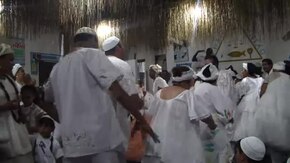Candomblé music
|
Candomblé
|
|
| Development phase: | 17th century |
| Place of origin: | Brazil |
| Stylistic precursors | |
| traditional African music of the slaves | |
| Instruments typical of the genre | |
| Atabaque , Gã , Xekerê | |
| Stylistic successor | |
| Afoxé , Maracatú , Axé | |
The music of the Candomblé is an elementary component of the ceremonies of the Afro- Brazilian Candomblé religion. The (drum) music forms a unit with the dance and song of the parishioners.
origin
The origin of the Candomblé lies in (West) Africa . Relatives v. a. the Yoruba , Ewe , Fon and Bantu brought their religion and the music that goes with it to Brazil in the course of slavery . That is why the music tradition of Candomblé is closely related to that of Santería in Cuba or Voodoo in Haiti , which have an analogous history, even if the individual religions were isolated from one another for centuries and did not influence one another. The common origins become very clear in the repertoire of the songs that are sung in both the Candomblé and the Santería in Yoruba and are often identical, while the accompanying drum music varies. In Brazil, macumba and umbanda are also of African origin. The ceremonies of both religions are also accompanied by singing and drums, but have their own musical traditions.
Although the toques (the various rhythms) are used in ceremonies to invoke the deities, they are not exclusively used for religious purposes. The Afoxé music of Bahia emerges directly from the music of the candomblé and the maracatú in Pernambuco probably has its roots in the ritual of the candomblé. In addition, many candomblé rhythms have found their way into the música popular brasileira ( MPB ), and also the popular axé music, as it is e.g. B. Daniela Mercury plays, is influenced by the Candomblé .
ceremony
The deities, the Orixás , are invoked by drums, song and dance, whereby some rhythms are only used for one Orixá, others, with different chants, are played for several Orixás. In total there are more than 50 different rhythms and, depending on the community, up to 500 different chants. The Orixás are called in a certain order at every ceremony: Exú , the doorkeeper, always comes first, followed by Ogum, Oxóssi , Obaluaiê, Ossaim, Oxumaré, Xangô , Oxum , Iansã, Nanã, Iemanjá and Oxalá .
The performance practice
The musician ensemble basically consists of three drummers and a bell. Its leader has the function of an Ogã , a high-ranking personality within the church hierarchy , and is called Alabê or Ogã de atabaque . While many high and highest positions in a Candomblé Terreiro are otherwise occupied by women, the field of drummers is reserved for men. It is sung by the congregation, in an alternating chant with a lead singer. In contrast to the holy children (the initiates, initiated), who (can) fall into a trance while dancing , this is not intended for the musicians, even excluded.
The game is played on atabaques , conga-like drums that come in three pitches. The deepest is the rum . It has a leading function, marks the individual sections of the dance and the singing, and is the only drum that has the freedom to (regulated) improvisation. The Rumpi is tuned a little higher , the highest is called Lê . The fourth instrument is the Gã ( gongue ), which the clave plays. Originally the Xekerê was also part of the range of instruments, but has disappeared almost everywhere over the years.
The different nations ( Naçoes ) of the Candomblé differ musically v. a. in the style of the Atabaques: In the Candomblé de Ketu , the Rum is played with one hand and a stick, Rumpi and Lê with two thin sticks. Both drums usually play the same accompaniment pattern, which creates a thick carpet under the rum phrases. In the Candomblé de Angola (and in the Candomblé de Caboclo ), on the other hand, all three drums are played with the hands, like on a conga. Here Rumpi and Lê have different voices. (for how to play, see also Atabaque )
Often the rhythms ( toques ) are in 6/8 or 12/8, but there are also 2/4 based toques: Vassi , which can be played for all Orixás , is in 6/8; Agueré , a toque for Oxóssi , is in 2/4.
literature
- Tiago de Oliveira Pinto: Capoeira, Samba, Candomble. Afro-Brazilian music in Reconcavo, Bahia. Reimer, Berlin 1991 (publications of the Museum für Völkerkunde Berlin NF, Dept. Musikethnologie 7). ISBN 3496004975
Music samples
- Candomblé - Documentos Folclóricos Brasileiros; Production: Roberto Batalin; Editora XAUÃ, Pça. Mahatma Gandhi; Guanabara Brazil
- Dudu Tucci : Orishas
- Capoeira, Samba, Candomblé (CD accompanying the book, see below literature)
- Luis da Muricoca: Candomble de Ketu
- Afro-Brazilian ritual
- Bresil-Candomble de Angola
